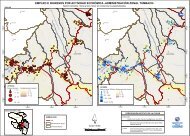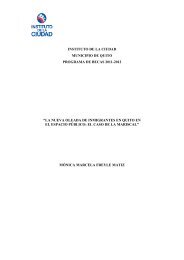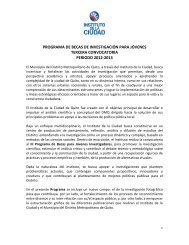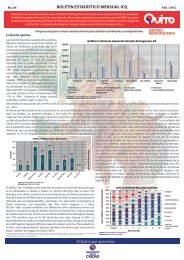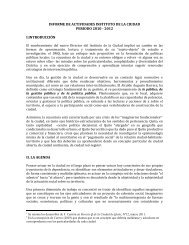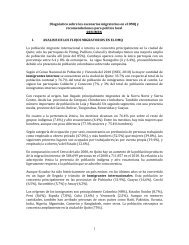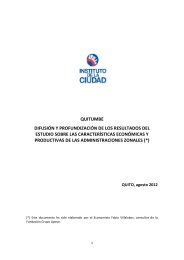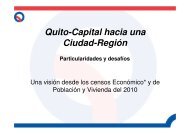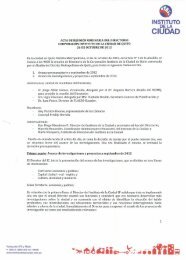Untitled - Instituto de la Ciudad
Untitled - Instituto de la Ciudad
Untitled - Instituto de la Ciudad
- No tags were found...
You also want an ePaper? Increase the reach of your titles
YUMPU automatically turns print PDFs into web optimized ePapers that Google loves.
Estrategias con zonas económicas especiales: un análisis comparativo <strong>de</strong> China, Corea e Indiariphery into the Center of Growth”,mimeo, ERIA.Kumar, R., (1989), Indian Export processingZones: An Evaluation (New Delhi: OxfordUniversity Press).Kundra, A (2000), The Performance of India’sExport Zones: A Comparison withthe Chinese Approach (New Delhi: SagePublication).Kung Kai-Sing, James (1985), “The Originsand Performance of China’s SpecialEconomic Zones”, Asian Journal of PublicAdministration, 7 (2), p. 198-215.Kusago, T. and Z. Tzannatos (1998), Exportprocessing zones: A Review in Need of anUpdate (Washington DC: World Bank).Lai H. H.(2006), “SEZS and Foreign Investmentin China: Experience and Lessonsfor North Korean Development”,en Asian Perspective, 30 (3), p. 69-97.Lewis, W. Arthur (1954), “Economic <strong>de</strong>velopmentwith unlimited supplies of <strong>la</strong>bor”,en Manchester School of Economicand Social Studies, 22, 139-91.Li, Y. (2006), “Tra<strong>de</strong> Ba<strong>la</strong>nce: NumbersCan be Deceiving”, en China and WorldEconomy, 14: 54-70.Liu B.J. & Y-Y Wu (2009), “DevelopmentZones in China: Are STIPs a Substitutefor or a Complement to ETDZs? Presentedat the ITEC Beijing InternationalPhD Workshop Organized by ITEC,Doshisha University, Kyoto, Japan, andDepartment of Political Economy, PekingUniversity, Beijing China. March 7.Madani, D. (1999), A Review of the Roleand Impact of Export Processing Zones(Washington DC: World Bank).Marshall, A. (1890), Principles of Economics(London: Macmil<strong>la</strong>n).Mathews, J.A. (2010), Strategizing in industrialclusters: Collective efficiency, increasingreturns and higher-or<strong>de</strong>r capabilities.Holger Crafoord Memorial Lecture,University of Lund, September 7.McKenney, K. (1993), An assessment of China’sspecial economic zones (WashingtonDC: National Defense University).Meng, G.W. (2005), “Evolutionary mo<strong>de</strong>lof free economic zones: Differentgenerations and structural features”, enChinese Geographical Sciences, 15 (2), p.103-12.Myrdal, G. (1957), Economic Theory andUn<strong>de</strong>r<strong>de</strong>veloped Regions (London: DuckworthPress).Ng, C. & L.F-Y Tuan, “The p<strong>la</strong>ce of FDIin China’s regional economic <strong>de</strong>velopment:Emergence of the globalized <strong>de</strong>ltaeconomies”, en Journal of Asian Economics,18 (2), p. 348-364.Nurkse, R. (1952), “Growth in un<strong>de</strong>r<strong>de</strong>velopedcountries”, en American EconomicReview, 42 (2), p. 571-83.Porter, Michael (1990), The CompetitiveAdvantage of Nations (New York: TheFree Press).(1998), “Clusters and the new economicsof competition”, en Harvard BusinessReview, 76 (6), p. 77-90.Rosenstein-Rodan, P. (1943), “Problems ofindustrialization of Eastern and SoutheasternEurope”, en Economic Journal,53, p. 202-211.Wang, J. (2009), “The Economic Impact ofSpecial Economic Zones: Evi<strong>de</strong>nce fromChinese, Municipalities, Job market”,mimeo, London School of Economics.World Bank (1992), Export processing zones(Washington DC: World Bank).Zheng, Doug<strong>la</strong>s (2010), Building enginesfor growth and competitiveness in China:Experience with special economic zonesand industrial clusters (Washington DC:World Bank).91Questiones Urbano Regionales



